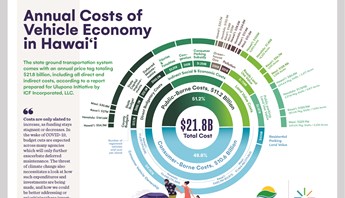The Costs of the Vehicle Economy in Hawaii (2021)
Cross-Sector
ICF Incorporated, L.L.C.
Clean Transportation
Why We Invested
To understand what Hawaii's current transportation investments truly are
(Note: Read the updated 2025 report here)
Hawaii’s vehicle transportation system comes with an annual price tag totaling $21.8 billion, including all direct and indirect costs, according to a new report released today by Ulupono Initiative.
“The Costs of the Vehicle Economy in Hawaii,” prepared for Ulupono Initiative by ICF Incorporated, LLC, reveals that more than half of the total $21.8 billion, $11.2 billion, is borne by the public in the form of state and county expenditures, social and economic trade-offs, and real estate value of land set aside for roadways and parking. The remaining amount, $10.6 billion, is borne directly by consumers in the form of vehicle ownership costs, including maintenance and operation.
“To help realize a more sustainable, resilient Hawaii, we need to understand what our current transportation investments are to know whether they are helping us meet our critical climate and community goals,” said Kathleen Rooney, Ulupono Initiative’s director of transportation policy and programs. “As in many places, transportation in Hawaii is a major budget expenditure that needs to be evaluated comprehensively.
Our Partner
ICF Incorporated, L.L.C., a global consulting services company, is internationally recognized for expertise and leadership in transportation assessment, benefit-cost analysis, greenhouse gas mitigation, and climate resilience planning. For more information about ICF, visit www.icf.com.
How We Partnered
Underwriting of research and analysis for the report to understand what Hawaii's current transportation investments truly are so that a more robust assessment of these investments can be made around important community goals and commitments.

Highlights of the Ulupono report include:
- Public costs amount to roughly $15,000 per taxpayer ($24,400 per household), annually, even if they don’t own a car.
- Personal vehicles cost an additional $16,200 per household per year. With the public costs above, each household’s costs total $40,600 per year (or 51 percent of pre-tax income).
- User fees amount to approximately $378 million, annually, almost half of the actual public roadway expenditures from the state and counties — and this gap will expand as 10-15 percent of the state’s highway system is projected to be directly impacted by sea level rise.
- The maintenance backlog is the same as the annual expenditures for both the state and the four counties combined. Our system and planning need to be re-evaluated and right-sized.
- Land value of public lands dedicated to road, highways, and parking is $3.9 billion, covering about 14 percent of the available urban land in our state.
- Many of the public costs are indirect but affect our communities greatly; for example, injuries and fatalities, congestion, greenhouse gas emissions and other pollution, and consumer parking subsidies.

